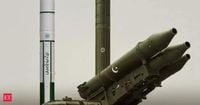ISLAMABAD – In a dramatic escalation of hostilities between nuclear-armed Pakistan and India, the Pakistani armed forces launched a Fatah-1 missile at India’s Udhampur Airbase on May 10, 2025, marking a sharp turn in the ongoing military standoff. Footage released by Pakistan’s military shows the precision launch of the Fatah-1 — a tactical, surface-to-surface guided missile — as part of what it calls Operation Bunyan ul Marsoos. According to Islamabad, the missile successfully hit key Indian military installations, including an airbase and a brigade command post. However, India claims it intercepted the projectile, downplaying the extent of damage caused.
The missile strike was described by Pakistani officials as a “measured response” to India’s overnight airstrikes that targeted Pakistani military positions. The Ministry of Defence stated that Pakistan’s latest move was intended to send “a clear message” about its readiness to respond with force. In response, Pakistan has alleged that India launched retaliatory missile attacks on three of its airbases, including Nur Khan Airbase near Islamabad — a claim yet to be verified by Indian authorities.
The crisis stems from an earlier wave of Indian airstrikes following a deadly militant attack in Pahalgam last month, which killed several Indian tourists. While New Delhi blames Pakistan-based groups for the incident, Islamabad has denied any involvement, accusing India of using the attack as a pretext for aggression. The situation along the Line of Control (LoC) has since deteriorated rapidly, with both sides reporting dozens of casualties. Pakistan cites 36 deaths from Indian strikes, while Indian sources report 16 fatalities caused by Pakistani shelling. Drone activity, missile launches, and cross-border artillery exchanges have been reported from multiple sectors, further inflaming tensions.
Despite the rising death toll and mounting international concern, neither side has signaled a willingness to step back. Calls for restraint from global powers have so far failed to halt the military escalation. With Pakistan showcasing its Fatah-1 capabilities and India mobilizing air and missile defenses, the standoff risks spiraling into a larger, more dangerous conflict — one with potential consequences far beyond the subcontinent.
The Fatah-II missile, also developed by Pakistan, is a guided artillery rocket system with an estimated range of around 250 to 400 kilometers. It is designed to strike military positions, radar installations, and logistics facilities. The Fatah-II, which can carry conventional warheads, was first officially tested in December 2021 and represents an upgraded version of the Fatah-I system.
India maintains a diverse missile arsenal developed primarily by the Defence Research and Development Organisation (DRDO). Key systems include the Pinaka Multi-Barrel Rocket Launcher (MBRL), the Pralay Short-Range Ballistic Missile (SRBM), and the BrahMos Supersonic Cruise Missile. The Pinaka has a shorter range, while the Pralay covers a broader spectrum, extending up to 500 kilometers. The BrahMos is known for its versatility and speed, capable of reaching Mach 3.
As tensions escalated, reports emerged of explosions in multiple areas in Pakistan early Saturday morning. A Reuters witness confirmed that three military sites were hit during the conflict. Meanwhile, blackout orders were issued in parts of India’s Punjab and Jammu & Kashmir following reported drone activity and loud noises. There is no official confirmation yet from the Indian side regarding the missile strike or the reported use of the BrahMos missile, which Pakistan alleges was used in the initial attack.
Pakistan’s military publicly announced the operational readiness of the Fatah-II system in recent years. The missile is launched from a mobile launcher, making it easier to deploy in the battlefield. The army has stated that the missile enhances its ability to conduct precision strikes at short and medium ranges. It is not part of Pakistan’s nuclear missile program and is classified as a tactical, conventional weapon.
The situation continues to be volatile as both nations remain on high alert. The Fatah-II missile, with its range of 400 kilometers, places it between India's Pinaka and Pralay systems, while its mobility allows for rapid deployment and flexibility in various combat scenarios. The strategic role of the Fatah-II is to conduct tactical precision strikes, similar to India's Pralay missile.
Operation Bunyan Ul Marsoos, which translates to 'solid wall of lead', reflects Pakistan's intention to portray itself as an impregnable force. The name is derived from a verse in the Quran, emphasizing the religious undertones of Pakistan’s military actions. This operation follows India’s airstrikes on May 7, which targeted nine sites in Pakistan and Pakistan-occupied Kashmir (POK) in retaliation for the April 22 Pahalgam terrorist attacks that resulted in the deaths of 26 civilians.
As the conflict escalates, Pakistan has been accused of using its missile strikes to target civilian and military areas, while India has focused on terror camps. This pattern of aggression raises concerns about the potential for further escalation and the risk of a broader conflict.
In this tense atmosphere, both nations are under pressure to de-escalate. However, the ongoing military actions suggest that neither side is prepared to back down. The international community watches closely, aware that any miscalculation could lead to a catastrophic outcome in a region already fraught with tension.
The current situation underscores the precarious balance of power in South Asia, as both nations continue to develop and showcase their military capabilities. With each side claiming to defend its sovereignty, the potential for a larger conflict looms ominously on the horizon.






